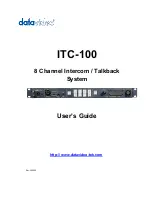
OPERATION IN iPOD MODE
In the iPod Mode, the Display Unit shows information received from the XIA Unit
that is operating in this mode. A pictorial of the display unit is shown in
Figure
1.
In the iPod Mode, the “up” and “down” arrow buttons are used for scrolling
through the information in iPod memory. New information from the iPod is sent
to the Display Unit each time the arrow buttons are pushed.
As an added feature, a browse mode can also be performed with the LCD
Display Unit. Using the “ENT” and “ESC” buttons, the user can enter and exit the
browse mode. The “up” and “down” scroll buttons are also used to scroll
through the information in the various categories. For example, pressing the
“ESC” button enters the browse mode. The Up and Down scroll buttons search-
es the information in the category. The “ENT” button is used to activate the
selection chosen from scrolling the information. When in the Browse mode, the
“ESC” button can be pressed at any time to go to the previous category or to
exit the Browse mode completely.
It should be noted that when the iPod Unit is working with the XIA interface, the
controls on the face of the iPod are disabled until it is disconnected from the
cable connecting it to the XIA interface.
PRODUCT DESCRIPTION
The XIA-LCD connects to the XIA interface to provide a visual display of informa-
tion from the iPod or XM Satellite Tuner whichever is the active device at the
moment.
The display mounts on the vehicle dashboard with several strips of adhesive tape
located on the rear of the unit. The LCD comes with a 4-pin DIN Connector for
mating to the XIA interface. The cable is approximately 6 ft in length. A typical
connection diagram with the XIA Adapter Unit is shown in
Figure 2.
The LCD display provides two lines of information containing 16 characters per
line. Typically, the top line is used to display the song title and the second line is
for the Artists Name. The unit is powered and controlled by the XIA interface. The
backlighting on the display is turned on by the application software, and remains
on until satellite or iPod mode is no longer selected, or power is disconnected
when vehicle is turned off.
A pictorial of the LCD Display Unit is shown in
Figure 1
. Four buttons on the unit
provide control signals to the XIA interface---Channel/Track Up; Channel/Track
Down; Enter; and Escape.
In the Satellite Tuner mode, the “Enter” and “Escape” buttons are not used.
UNIT MOUNTING
The LCD Display Unit comes equipped with four adhesive strips secured to the
bottom. Remove the protective covering over the adhesive strips to expose the
tacky surface area, and secure the unit to the vehicle dashboard. The display unit
should be positioned for easy accessibility from the driver and passenger posi-
tions in the front seats of the vehicle. The cable should be run to the XIA interface
that mounts under the dashboard and close to the vehicle radio.
OPERATION IN SAT MODE
The LCD Display Unit shows information from the XIA interface that is operating in
the Satellite Tuner (SAT) Mode. As shown in
Figure 1
, the “up” and “down” arrow
buttons are used to select the next or previous channel/station. As the buttons are
pushed and the XM Receiver performs the change, new information from the
Receiver is sent to the Display Unit. This could be Station Name, Song Title, and
Artist. The “ENT” and “ESC” buttons are not used in the SAT Mode.
iPOD Digital Interface
iPOD Digital Interface
REMOTE LCD DISPLAY
REMOTE LCD DISPLAY
ACCESS
ACCESS
<Line 1>
<Line 2>
ENT
ESC
Figure 1
Figure 2
TYPICAL XIA INTERFACE DIAGRAM
WITH LCD DISPLAY UNIT
(XIAH CABLES SOLD SEPARATELY)
3
XIA-LCD
4
2
To XM Receiver
XIAH-IPC (iPOD cable)
To iPOD Unit
To LCD Display
(XIA-LCD)
The XIAH-AUX (Auxiliary Input cable) can be
plugged into the XM or iPOD port.
XiA
Interface
XIAH-XMC (Xm cable)




















